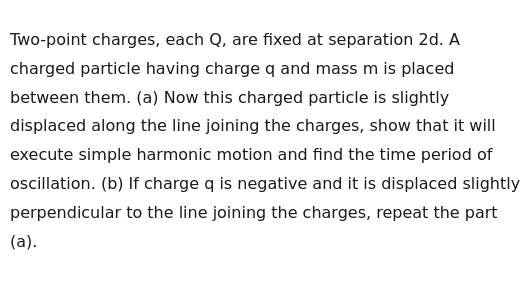Question
Question: Two-point charges, each Q, are fixed at separation 2d. A charged particle having charge q and mass m...
Two-point charges, each Q, are fixed at separation 2d. A charged particle having charge q and mass m is placed between them. (a) Now this charged particle is slightly displaced along the line joining the charges, show that it will execute simple harmonic motion and find the time period of oscillation. (b) If charge q is negative and it is displaced slightly perpendicular to the line joining the charges, repeat the part (a).

a) T = 2\pi \sqrt{\frac{m d^3 \pi\epsilon_0}{Qq}}, b) T = 2\pi \sqrt{\frac{2m d^3 \pi\epsilon_0}{Q|q|}}
Solution
The problem involves analyzing the motion of a charged particle under the influence of two fixed charges. For simple harmonic motion (SHM) to occur, the net force on the displaced particle must be a restoring force, i.e., proportional to the displacement and directed towards the equilibrium position (F = -kx).
Let the two fixed charges Q be located at (-d, 0) and (d, 0). The separation between them is 2d.
Part (a): Charged particle q (mass m) displaced along the line joining the charges.
-
Equilibrium and Stability: For the particle
qto execute SHM when displaced along the line joining the charges, the equilibrium position at(0, 0)must be stable. This happens ifQandqhave the same sign (e.g., both positive). Ifqis positive and displaced to(x, 0)(wherex << d), the repulsive force from theQat(d, 0)will increase, and the repulsive force from theQat(-d, 0)will decrease. This creates a net force pushingqback towards(0, 0). -
Forces: Let
qbe displaced by a small distancexalong the x-axis, so its position is(x, 0).- The force
F_1onqdue toQat(-d, 0)isF_1 = \frac{kQq}{(d+x)^2}(directed to the right, away from-d). - The force
F_2onqdue toQat(d, 0)isF_2 = \frac{kQq}{(d-x)^2}(directed to the left, away fromd).
Where
k = \frac{1}{4\pi\epsilon_0}. - The force
-
Net Force: The net force
F_netonqisF_net = F_1 - F_2.F_net = kQq \left[ \frac{1}{(d+x)^2} - \frac{1}{(d-x)^2} \right]F_net = kQq \left[ \frac{(d-x)^2 - (d+x)^2}{(d+x)^2 (d-x)^2} \right]F_net = kQq \left[ \frac{(d^2 - 2dx + x^2) - (d^2 + 2dx + x^2)}{(d^2 - x^2)^2} \right]F_net = kQq \left[ \frac{-4dx}{(d^2 - x^2)^2} \right] -
Small Displacement Approximation (
x << d): For smallx,(d^2 - x^2)^2 \approx (d^2)^2 = d^4.So,
F_net \approx kQq \left( \frac{-4dx}{d^4} \right) = - \left( \frac{4kQq}{d^3} \right) x. -
SHM and Time Period: The net force is of the form
F_net = -K_{eff} x, whereK_{eff} = \frac{4kQq}{d^3}. This indicates simple harmonic motion.The angular frequency
\omega = \sqrt{\frac{K_{eff}}{m}} = \sqrt{\frac{4kQq}{md^3}}.The time period
T = \frac{2\pi}{\omega} = 2\pi \sqrt{\frac{md^3}{4kQq}}.Substituting
k = \frac{1}{4\pi\epsilon_0}:T = 2\pi \sqrt{\frac{md^3}{4 \left(\frac{1}{4\pi\epsilon_0}\right) Qq}} = 2\pi \sqrt{\frac{m d^3 \pi\epsilon_0}{Qq}}.
Part (b): If charge q is negative and it is displaced slightly perpendicular to the line joining the charges.
-
Equilibrium and Stability: Since
qis negative andQis positive, the forces are attractive. Whenqis displaced perpendicular to the line joining the charges, say to(0, y)(wherey << d), the attractive forces fromQat(-d, 0)and(d, 0)will have components that pullqback towards(0, 0). This ensures stable equilibrium. -
Forces: Let
qbe displaced by a small distanceyalong the y-axis, so its position is(0, y).- The distance from each
Qtoqisr = \sqrt{d^2 + y^2}. - The magnitude of the force from each
QonqisF = \frac{kQ|q|}{r^2} = \frac{kQ|q|}{d^2 + y^2}. - Let
\thetabe the angle between the line connectingQandqand the x-axis. Then\sin\theta = \frac{y}{r} = \frac{y}{\sqrt{d^2 + y^2}}. - Due to symmetry, the x-components of the forces cancel out.
- The y-components add up. Since
qis negative, the forces are attractive, pullingqtowards eachQ. Thus, the y-component of each force will be directed downwards (towards the x-axis). - Net force in y-direction:
F_y = -2 F \sin\theta. F_y = -2 \left( \frac{kQ|q|}{d^2 + y^2} \right) \left( \frac{y}{\sqrt{d^2 + y^2}} \right)F_y = - \frac{2kQ|q|y}{(d^2 + y^2)^{3/2}}.
- The distance from each
-
Small Displacement Approximation (
y << d): For smally,(d^2 + y^2)^{3/2} \approx (d^2)^{3/2} = d^3.So,
F_y \approx - \frac{2kQ|q|y}{d^3}. -
SHM and Time Period: The net force is of the form
F_y = -K_{eff} y, whereK_{eff} = \frac{2kQ|q|}{d^3}. This indicates simple harmonic motion.The angular frequency
\omega = \sqrt{\frac{K_{eff}}{m}} = \sqrt{\frac{2kQ|q|}{md^3}}.The time period
T = \frac{2\pi}{\omega} = 2\pi \sqrt{\frac{md^3}{2kQ|q|}}.Substituting
k = \frac{1}{4\pi\epsilon_0}:T = 2\pi \sqrt{\frac{md^3}{2 \left(\frac{1}{4\pi\epsilon_0}\right) Q|q|}} = 2\pi \sqrt{\frac{2m d^3 \pi\epsilon_0}{Q|q|}}.
The motion will be simple harmonic in both cases under the specified conditions.
The final answer is a)T=2πQqmd3πϵ0,b)T=2πQ∣q∣2md3πϵ0
Explanation of the solution:
(a) For longitudinal displacement, assuming Q and q have the same sign for stability, the net force on q displaced by x is F_x = kQq [1/(d+x)^2 - 1/(d-x)^2]. For x << d, this simplifies to F_x = -(4kQq/d^3)x. This is a restoring force F=-Kx. The time period is T = 2\pi \sqrt{m/K} = 2\pi \sqrt{md^3/(4kQq)} = 2\pi \sqrt{m d^3 \pi\epsilon_0 / Qq}.
(b) For perpendicular displacement, with q negative, the attractive forces from Q on q (displaced by y) have y-components adding up to F_y = -2kQ|q|y / (d^2+y^2)^{3/2}. For y << d, this simplifies to F_y = -(2kQ|q|/d^3)y. This is a restoring force F=-K'y. The time period is T = 2\pi \sqrt{m/K'} = 2\pi \sqrt{md^3/(2kQ|q|)} = 2\pi \sqrt{2m d^3 \pi\epsilon_0 / (Q|q|)}.
Answer:
(a) The time period of oscillation is T = 2\pi \sqrt{\frac{m d^3 \pi\epsilon_0}{Qq}}.
(b) The time period of oscillation is `T = 2\pi \sqrt{\frac{2m d^3 \pi\epsilon_0}{Q|q|}}$.
